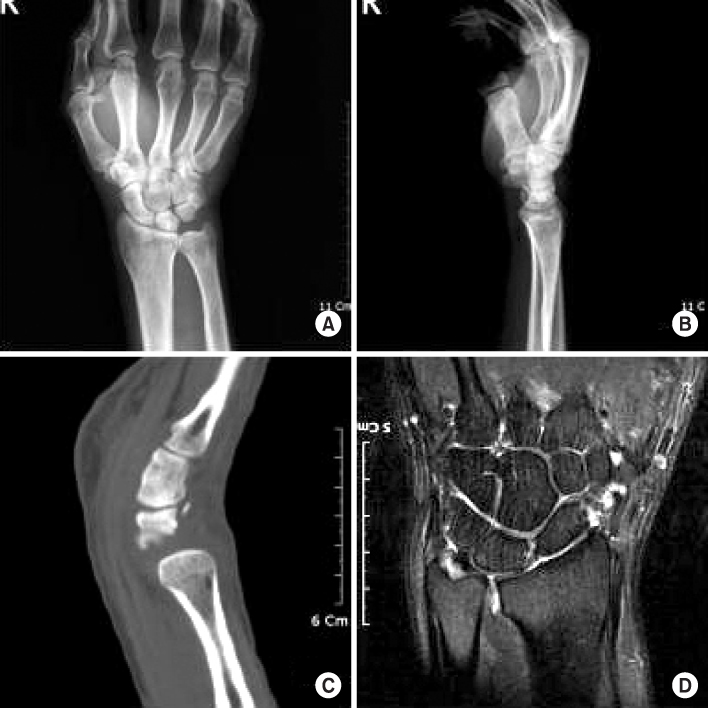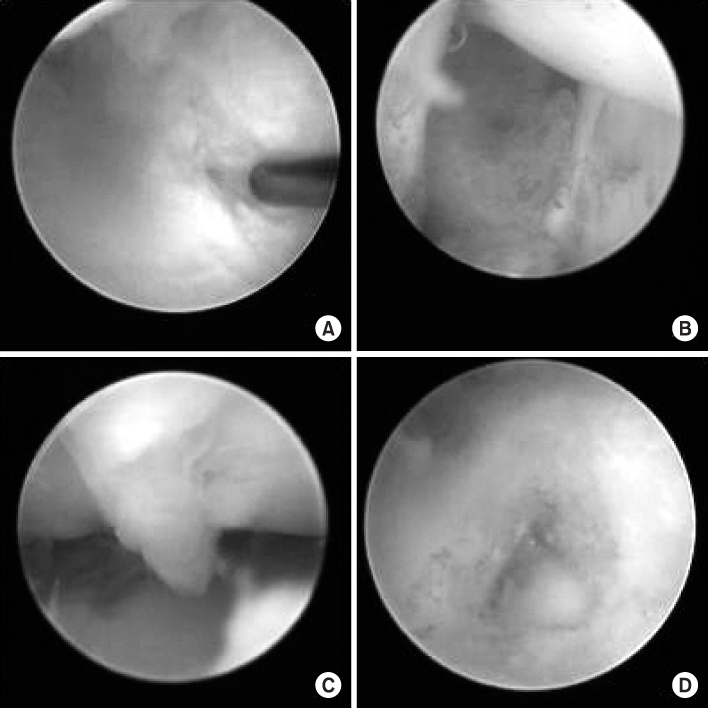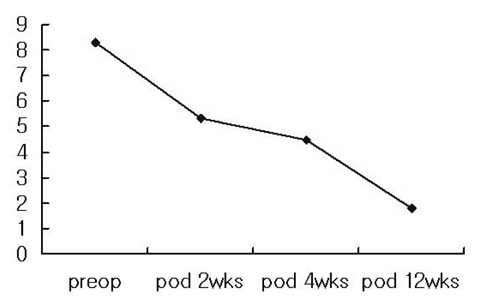J Korean Fract Soc.
2009 Jul;22(3):179-184. 10.12671/jkfs.2009.22.3.179.
TFCC Injury Associated with the Triquetral Dorsal Chip Fracture
- Affiliations
-
- 1Department of Orthopedic Surgery, Konkuk University School of Medicine, Seoul, Korea. lsjmd@kuh.ac.kr
- 2Department of Orthopedic Surgery, Korea University College of Medicine, Ansan Hospital, Ansan, Korea.
- KMID: 2063907
- DOI: http://doi.org/10.12671/jkfs.2009.22.3.179
Abstract
-
PURPOSE: To evaluate the usefulness of wrist arthroscopic examination in patient with persistent pain after the triquetral dorsal chip fracture and also to determine its relationship with TFCC injury in the triquetral dorsal chip fracture patient manifesting persistent pain.
MATERIALS AND METHODS
This study is based on six cases presenting persistent pain in the ulnar aspect after the triqeutral posterior cord fracture that were treated conservatively. Wrist arthroscopy was carried out for all six cases. All were preoperatively and postoperatively evaluated using VAS pain scale, grip power, ulnar grind test, Kleinman shearing test and lunotriquetral ballottment test.
RESULTS
Preoperatively, ulnar grind test yielded positive results in all six cases, Kleiman shearing test proved positive in three cases and lunotriquetral ballottment test yielded positive result in one case. In the arthroscopic findings, synovitis and TFCC injury were detected in all cases, and based on Palmer classification of TFCC injury, type IA was determined in five cases and type ID in one case. Arthroscopic TFCC partial resection and synovectomy were carried out. VAS pain scale improved from an average 8 points preoperatively to 3 points postoperatively. The difference of grip power between the normal and the other side improved from average of 15 lb preoperatively to 5 lb postoperatively. Based on postoperatively physical examination at 6 weeks, all cases yielded negative results in the ulnar grind test and Kleiman shearing test.
CONCLUSION
We think that TFCC injury is one of the causes of persistent pain after triquetral dorsal chip fracture. We recommend an arthroscopic TFCC partial resection as a valuable treatment option.
Keyword
Figure
Reference
-
1. Abboud JA, Beredjiklian PK, Bozentka DJ. Nonunion of a triquetral body fracture. A case report. J Bone Joint Surg Am. 2003; 85:2441–2444.2. Bartone NF, Grieco RV. Fractures of the triquetrum. J Bone Joint Surg Am. 1956; 38:353–356.
Article3. Botte MJ, Gelberman RH. Fractures of the carpus, excluding the scaphoid. Hand Clin. 1987; 3:149–161.
Article4. Bryan RS, Dobyns JH. Fractures of the carpal bones other than lunate or navicular. Clin Orthop Relat Res. 1980; 149:107–111.5. De Beer JD, Hudson DA. Fractures of the triquetrum. J Hand Surg Br. 1987; 12:52–53.
Article6. Failla JM, Amadio PC. Recognition and treatment of uncommon carpal fractures. Hand Clin. 1988; 4:469–476.
Article7. Garcia-Elias M. Dorsal fractures of the triquetrum. avulsion or compression fractures? J Hand Surg Am. 1987; 12:266–268.8. Höcker K, Menschik A. Chip fractures of the triquetrum. J Hand Surg Br. 1994; 19:584–588.
Article9. Levy M, Fischel RE, Stern GM, Goldberg I. Chip fractures of the os triquetrum: the mechanism of injury. J Bone Joint Surg Br. 1979; 61:355–357.
Article10. Schubert H. Triquetrum fracture. Can Fam Physician. 2000; 46:70–71.11. Shah MA, Viegas SF. Fractures of the carpal bones excluding the scaphoid. J Am Soc Surg Hand. 2002; 2:129–140.
Article12. Smith DK, Murray PM. Avulsion fractures of the volar aspect of the triquetral bone of the wrist: a subtle sign of carpal ligament injury. AJR Am J Roentgenol. 1996; 166:609–614.
Article13. Suzuki T, Nakatsuchi Y, Tateiwa Y, Tsukada A, Yotsumoto N. Osteochondral fracture of the triquetrum: a case report. J Hand Surg Am. 2002; 27:98–100.
Article
- Full Text Links
- Actions
-
Cited
- CITED
-
- Close
- Share
- Similar articles
-
- Triangular Fibrocartilage Complex and Lunotriquetral Ligament Injury of Distal Radius Fracture
- Traumatic Triangular Fibrocartilage Complex Injuries and Instability of the Distal Radioulnar Joint
- Novel Therapeutic Approach for Extensor Digiti Minimi Tendon Traction in Chronic Ulnar-Sided Wrist Pain Diagnosed as Triangular Fibrocartilage Complex Injury: A Case Report
- Dorsal Approach for Distal Radius Fractures
- Intra-Articular Injury Associated with Distal Radius Fracture




